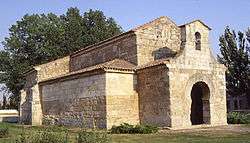Church of San Juan Bautista, Baños de Cerrato
| San Juan Bautista de Baños de Cerrato | |
|---|---|
 | |
| Basic information | |
| Location | Baños de Cerrato, Castile and León, Spain |
| Geographic coordinates | 41°55′15″N 4°28′20″W / 41.9208°N 4.47236°W |
| Affiliation | Christianity |
| Architectural description | |
| Architectural style | Visigothic |
| Completed | 7th century |
The Church of San Juan Bautista or San Juan Bautista de Baños de Cerrato is an ancient stone Visigothic church dedicated to St John the Baptist in the town of Baños de Cerrato, ancient Balneos, in the province of Palencia, in central Spain. It is one of the earliest and most complete survivals of Visigothic architecture, founded in the 7th century.
History
The church is located in the fertile Pisuerga River valley, near the confluence with the Carrión River. The nearby town of Venta de Baños is presently larger and more important than Baños de Cerrato. In Roman times, the area was devoted to vacationing and relaxation, with many private villas dotting the landscape. In Roman times as under the Visigoths, this was an important grain-producing region.
The church was commissioned by the Visigothic king Recceswinth of Hispania (the Iberian Peninsula, comprising modern Spain and Portugal), in the year 661 and whose solemn consecration ceremony is believed to have taken place on the 3rd of January, 661.
The church was built as a royal foundation under the control of the Bishops of Palencia. The excavations that were carried out in 1956 and 1963 yielded a medieval necropolis of 58 tombs to the north-west of the church and discovered three pieces of 7th-century bronze: two belt buckles in the shape of a lyre and one liturgical object.
Architecture
According to scholars, it is the oldest and best surviving Visigothic church in Spain. Moreover, it has an original inscription in the stones over its entry, in awkward capital letters. This text is also preserved in a codex of the 10th century, copied from a Toledan manuscript from the 8th century.
The church construction is of ashlar (squared stone, as against irregular rubble) set in a drywall manner (with no mortar). It and several other Visigothic churches built in Spain about the same time represent the last ashlar construction in western Europe until Charlemagne, and can be seen as the end of that ancient Roman building tradition in the west. George R.H. Wright notes the Syrian influence seen in the horseshoe-shaped arch in pre-Islamic Spain. The belfry above was added at a later date.[1]
See also
References
External links
| Wikimedia Commons has media related to Church of San Juan Bautista, Baños de Cerrato. |
- The Church (Spanish)
- The Visigothic Baths (Spanish)